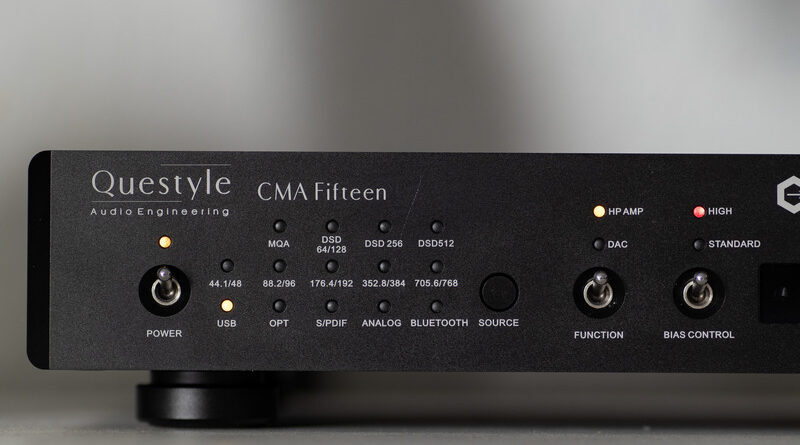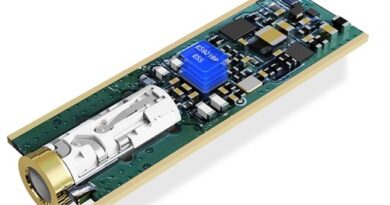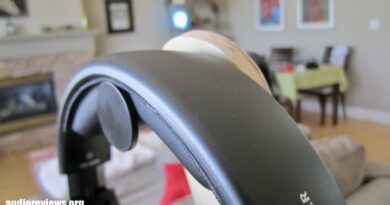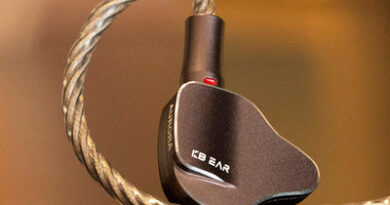Questyle CMA Fifteen Review – The Great Sequel
Pros — Excellent transparency, highly resolving signature
– Staging and imaging is nearly as good as it gets
– Great separation and layering, rivaling that of separated DAC/Amp setups
– MQA HW full-decoder (for Tidal users)
– High quality components with isolated USB controller and integrated low-noise PSU
– BT connectivity is solid, even though wired connectivity is noticeably better
– Rock-solid build with much improved volume knob
– An analog line-in (finally!)
Cons — Questyle CMA FIfteen lacks balanced/XLR line-in
– Sparse accessories
– Gain switches hard to reach
– Not the best pairing with very bright headphones
In this Article
INTRODUCTION
Questyle has slowly become one of the most consistent manufacturers around. Nearly all of their releases are either excellent, or extremely competitive at their respective price-tier.
I have been using the Questyle CMA-400i for the past two years, using it as a reference desktop source. The Questyle CMA Twelve, meanwhile, has managed a place at our Wall of Excellence as one of the best TOTL DAC-Amps around.
Naturally the CMA Fifteen has to bear the weight of high expectations. Anything short of excellence in terms of sonic performance is a letdown. Let’s see if Questyle can maintain the track record with their latest flagship.
Note: the ratings given will be subjective to the price tier. Questyle was kind enough to send me the CMA Fifteen as part of the Review Tour. The unit was sent to the next reviewer afterwards.
Headphones and IEMs used: Final Sonorous III, Sennheiser HD650/HD820/HD560S, HiFiMAN HE-6se V2/HE-400i/Deva Pro, Meze 99 Classics, Dunu Zen, Earsonics Onyx
Price, while reviewed: $2400. Can be bought from HiFiGo.
PHYSICAL THINGS AND USABILITY
PACKAGING AND ACCESSORIES
Questyle does not provide a lot in terms of accessories. A remote, a power cord, the CMA Fifteen itself, and that’s about it. The remote is pretty handy esp for volume adjustment and muting, but many of the buttons do not really work (since this is a universal remote for all Questyle products).
BUILD QUALITY
In one word: excellent. The machined aluminium chassis has a solid, dense feeling. The top panel can be unscrewed by removing the 8 screws (do note the differing lengths of the screws at corners). There’s an option to replace the top aluminium panel with a plexiglass panel but I recommend against it since heat dissipation becomes worse that way.
The front of the unit is full of knobs and lights. Some might find it too busy, and I agree. Having four different logos/trademarks do not help either. Questyle does a far better job with the CMA-400i front panel (where additional logos are shifted to the top panel) so I wonder why they did not choose so here.
Most of the controls on the front panel are self-explanatory. The “Function” button switches between using the CMA Fifteen as a DAC-Amp or a DAC-Preamp. This is a very useful function as with a flip of a switch I can go from my headphones to my powered speakers, for example.
The “bias control” switch meanwhile turns the High Bias mode on or off. More on this later. Also note that all three of the front panel outputs are active at the same time, so I’d advise against keeping sensitive IEMs or headphones plugged in alongside hard-to-drive ones (as once you push the volume for the inefficient ones, the efficient ones will get progressively louder as well).
The volume knob has a cool trick: it rotates accordingly when changing the volume via the remote. The feel and quality of the volume knob is also improved over the previous Questyle DAC/AMps e.g. my Quesytle CMA-400i knob got loose over time. I could fix it by tightening the screw inside again, but it needed some fiddling.
Looking at the back of the device, you have all the expected inputs and outputs. Questyle has a type-C and regular USB type-B input to keep up with modern standards. The USB inputs get the highest priority, but of course you can switch to other inputs with the switch at the front.
The surprising (for Questyle) inclusion is the RCA input. Previous Questyle all-in-ones lacked an analogue input and this made it impossible to use the amp section alone. That’s not the case anymore with the CMA Fifteen, though I’d have preferred an XLR input as well (though space constraint could’ve been a reason for excluding that).
Then we find the stereo outputs and this time XLR-out is available. The line-out can have fixed or variable voltage, and the line-out level can also be adjusted between 14dBu and 20dBu. Lastly, we find the BT module (with LDAC support), a button to pair the DAC-Amp with a BT device, a voltage switch (110V or 220V), and the power input with a fuse underneath.
My only gripe: the gain switch at the bottom. There are four separate DIP switches and you have to individually switch them to the desired gain level. The procedure is annoying as it’s not easy to switch gain on the fly for sensitive stuff. You have to flip the entire unit to gain access. Given that vertical mount does not work here like CMA-400i, you have to fiddle with the unit at times if you intend to use sensitive IEMs and power-hungry planars.
TECH INSIDE THE CMA FIFTEEN
Questyle is known for their clean PCB design and the use of high quality components, and the CMA Fifteen is no exception. The space on the PCB is well-utilized with the DAC, Amp, and PSU components having their separate “grouping”. The components themselves are sourced from reputed brands, e.g. WIMA film caps, Nichicon Fine Gold series caps, DALE resistors, Plitron/Noratel toroidal transformer etc.
The USB controller sits on top the motherboard on a separate “daughterboard” and is connected to the main PCB via a ribbon interface. It’s an XMOS controller, as is the norm nowadays (apart from Schiit who make their own controller).
Another interesting inclusion is the Linear PSU within the unit itself. The CMA-400i lacked this while the CMA Twelve/Twelve Master included a linear PSU as well (though smaller in size). As a result, you won’t have to shell out extra money on external PSUs or “noise filtering” devices.
Finally, let’s have a look at the discrete four-channel current-mode amp section. The voltage-rail caps are on the right whereas the individual amp channels have the DIP switches directly coupled with them at the bottom. This is why you have to switch four different switches just to go from low to high gain, or vice-versa. On the left, you see the ES9038Pro DAC chip, which is the highest performing Sabre chip on the market right now. To learn more about Current-mode amplification, have a look here.
Speaking of the DAC chip, Questyle picked the ES9038Pro since it’s a current-mode DAC chip, and coupled with Questyle’s Current-mode Amp topology, this system can negate the need of IV conversion between the DAC and the Amp, resulting in a more direct signal path. Does this improve the sound quality? Well, that’s hard to gauge, but this is cool from an engineering perspective anyway.
Finally, a list of the technical spec, taken straight out of Questyle’s CMA Fifteen page:
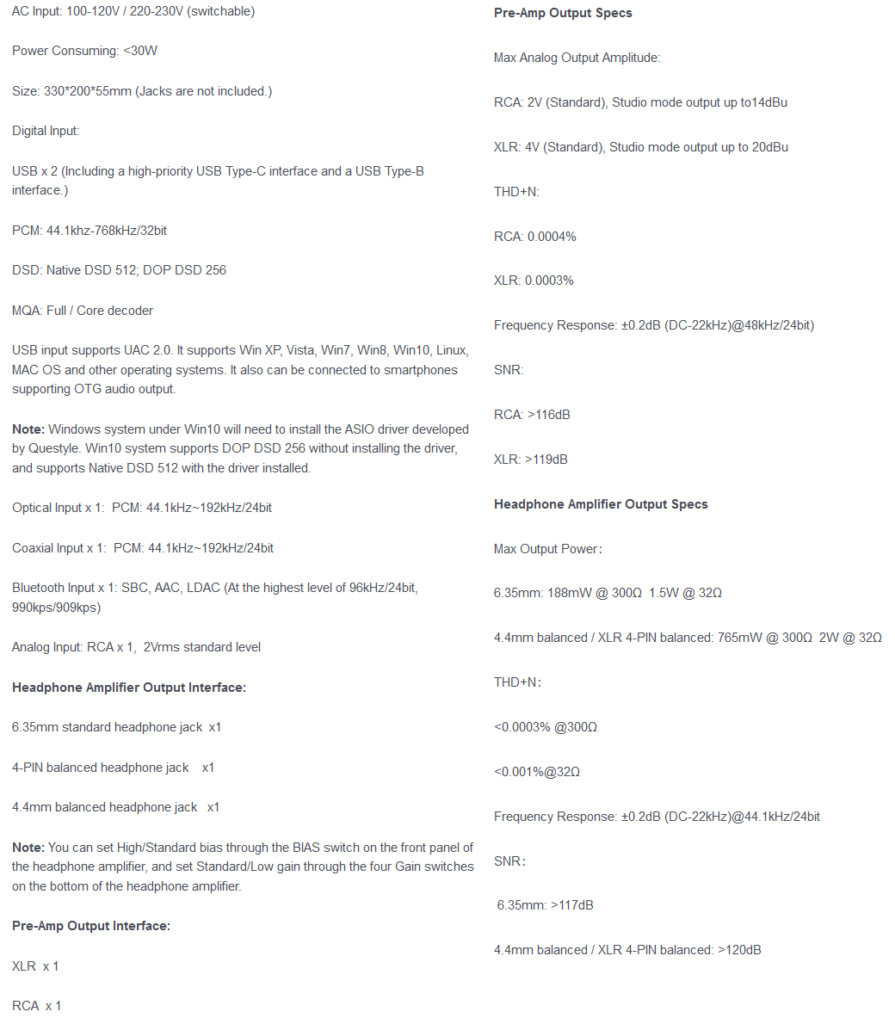
TONALITY AND TECHNICALITIES
Listening setup: Questyle CMA Fifteen connected directly to a desktop gaming PC and alternatively an Apple Macbook Pro (M1 Max). The Macbook Pro ran on battery during listening test. There was no noticeable difference between sound or noise level between these systems, proving that the noise filtering on the CMA Fifteen is doing a good job.
To describe the tonality in one word: Super-transparent. I’ll describe some general traits here, and then move on to pairing with several headphones/IEMs since when talking about sources, pairings are the only way to judge them properly.
The mids are intoxicating, every slight nuance of vocal delivery or guitar strumming being vividly portrayed. The highs are very resolving without a hint of edginess or grain. Notes are slightly rounded but not overly so.
Soundstage is engulfing and stage depth is exemplary. Imaging is precise and differs slightly from most DACs in terms of panning from center to left or right. It’s hard to describe but center imaging is better on the CMA Fifteen than most solid-state DAC-Amps I’ve tried in the TOTL space.
Bass is not as spectacular as the rest of the stuff, given the uncolored, neutral presentation on that front. That being said, even on headphones with relatively “poor” bass e.g. HD650 the mid-bass punch and note delivery was spot-on. Bass is mostly focused on the dexterity of the delivery rather than having a rich, dense bass response.
This highly resolving signature comes at the cost of one detriment: CMA Fifteen is unforgiving to poor mastering or recording flaws. Moreover, peaks and dips in the frequency response of IEMs and headphones are laid bare to the listener. If you want your source to be on the forgiving side, CMA Fifteen ain’t it.
MQA hardware decoding works, and MQA tracks sounded somewhat better with the HW decoding turned on than off (in the desktop Tidal app). Make of that what you will, but I did a blind A/B and it was that.
PAIRING NOTES
Let’s address the noise level first. There is very faint hiss with the likes of Andromeda or Final FI-BA-SS. Most IEMs are hiss-free and has excellent dynamics. Generally, the CMA Fifteen pairs especially well with planars and high-impedance dynamic drivers (with high bias on). Note that the high bias mode ensures a longer operation in pure class-A mode.
with Sennheiser HD650
One potential issue I found was that the HD650 would sound slightly shouty in Standard bias mode. Turning on high bias solved that for me (and I did a blind A/B testing just to be sure it’s not a placebo). This was the only time when high bias mode made a very noticeable difference, so I think other high impedance headphones might benefit from this mode as well.
Other than that: exceptionally balanced sound from the HD650. The mids were intoxicating in high bias mode, and the treble was extended without being too subdued or up-front. The bass roll-off isn’t addressed, and bass is the weakest link here (to fix that you really need an OTL amp with the HD650). As far as solid-state pairings go, CMA Fifteen drive and pair with the HD650 as well as anything out there.
with Final Sonorous III
The Final Sonorous III are quite susceptible to source changes, and also very efficient to drive so it’s easy to “over-drive” them on a source that’s just all about grunt and little about “finesse”. The CMA Fifteen handles low impedance loads very well, Sonorous III did not have any edginess in the treble (which appears on subpar sources or when being over-driven). As an aside: Meze 99 Classics also paired extremely well with the CMA Fifteen with the bass being less bloomy and bloated than out of an iFi Zen Can, for example.
with HiFiMAN HE-6se V2
The HiFiMAN HE-6se V2 are notoriously difficult to drive with a sensitivity of only 83dB/mW. People are often using speaker amps to drive them (at times in a monoblock config which is nuts) so the CMA Fifteen are up for a challenge.
And fortunately, they pass that challenge with aplomb. The bass slams hard, with the treble being bright and sparkly but not grainy or super-aggressive (which is the case when the HE-6se V2 are underpowered). Staging was improved noticeably over my CMA-400i and the SMSL SP-400. All of this without having to go past the 12 o’clock position in the volume knob (which is very loud for me).
If you own planar magnetic headphones, very few DAC-Amps will perform as well as the CMA Fifteen.
with Dunu Zen
Dunu Zen is a single dynamic driver IEM that’s very susceptible to background hiss/high noise-floor on the source side. Fortunately, CMA Fifteen has a mostly quiet background, with subtle “hum” being evident when no music is playing. Once the music starts playing even that fades away.
In terms of sound, the Zen had excellent dynamics and also benefitted from the midrange transparency that the CMA Fifteen offers. I do find the pairing with Cayin C9 to be even better when it comes to Zen, but that is a different class of device altogether.
SELECT COMPARISONS
vs Questyle CMA-400i
Being my daily driver, I am fairly accustomed to the CMA-400i sound signature. To summarize, the CMA-400i is less resolving, with the mids being not as engaging. The staging is less expansive as well, though imaging is largely similar.
The bass has slightly more weight on the CMA-400i though faster bass sections are better rendered on the CMA Fifteen. Output power is also noticeably higher on the CMA Fifteen with nearly double the current. CMA-400i also has more background hiss with sensitive IEMs.
Overall, the CMA Fifteen is an upgrade over the CMA-400i, though the 3x increase in price make the CMA-400i an even better value-for-money.
vs Questyle CMA Twelve
In terms of feature-set and output power, these two DAC-Amps are largely similar. The CMA Fifteen have analog input which is a plus.
As for sound, CMA Twelve has slightly more warmth and less expansive stage, and the treble is a bit more rounded. The bass has more weight and slam on the CMA Twelve, but the CMA Fifteen can give the sensation of better “separation” between notes. Mids are also more engaging on the CMA Twelve with even better transparency.
In essence, the CMA Twelve is not too far off the performance of the Fifteen. It’s mostly the stage size and the space between instruments that are larger, grander on the CMA Fifteen, and the bass being more nimble than weighty.
vs iFi Pro iDSD SIgnature
The iFi Pro iDSD Signature has more tuning options and better output selection but it sounds less resolving with a more intimate presentation. Separation of instruments are also not as outlined as the CMA Fifteen. Moreover, planars fared better with the CMA Fifteen, with the HE-6 having more slam on the CMA Fifteen while sounding somewhat anemic on the Pro iDSD Signature in default configuration (no bass boost engaged).
That being said, with the right pairing e.g. bright headphones, the Pro iDSD can sound magnificent. Also the bass boost and tube modes are really well-implemented, so if you are into tweaking the sound of your headphones, Pro iDSD Signature has more to offer there.
CONCLUSION
Questyle CMA Fifteen is a solid all-rounder. It sounds great with almost any headphones and IEMs out there, and it sounds exceptional with planar magnetic headphones. The build is very good, the output power is more than enough for almost any headphones, and the size of the unit is petite enough to be put on the desk alongside your PC and powered monitors.
The only complaint I have is the crowded front-panel, a lack of XLR input, and perhaps a way to apply analog tone-control, something iFi Pro iDSD Signature offers. Other than that – nothing, really.
It’s rare that I come across a device so complete, and something that may stop you from purchasing further gears because it does everything so well. The Questyle CMA Fifteen earns my highest recommendation, and also gets a place in our Wall of Excellence, replacing the previous CMA Twelve Master.
Job well done, Questyle!
MY VERDICT
4.75/5
DISCLAIMER
Get it from HiFiGo
Our generic standard disclaimer.
PHOTOGRAPHY
You find an INDEX of our most relevant technical articles HERE.



